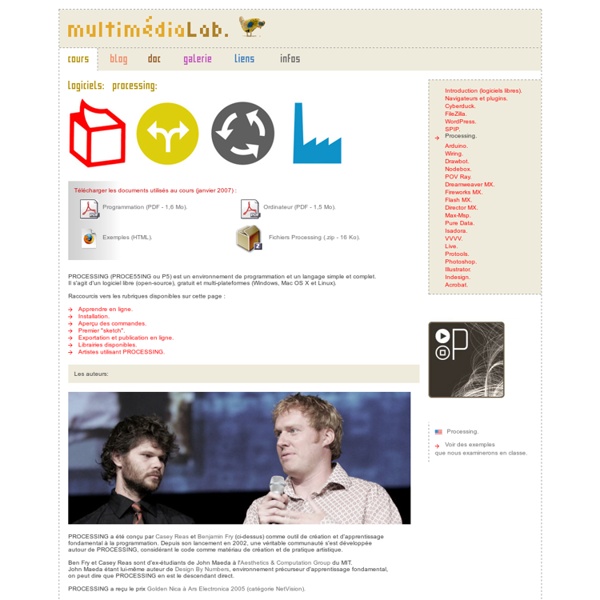Phishing At The River Of News : Florian Jenett
Die Installation „Phishing At The River Of News“ besteht aus einer Reihe von gebrauchten Computer-Röhrenmonitoren verschiedenster Fabrikate, die Bildfläche neben Bildfläche sowie auf ihren Rückseiten liegend auf dem Boden arrangiert sind. Die Monitore zeigen alle das gleiche Bild, welches von einer im Hintergrund laufenden Software erzeugt wird. Zu sehen sind wechselnde Muster aus je einem Internet-Werbebanner, der live geladen wird. Die Werbebanner - live und ungefiltert aus dem Internet heruntergeladen - transportieren die unterschiedlichsten Inhalte, die gerade in diesem Moment irgendwo auf der Welt beworben werden.
Mobile Processing
Abstraction Now! - catalogue
Der Katalog zur Ausstellung ist zweisprachig, in deutsch und englisch, im September 2004 in der Edition Camera Austria erschienen. (Umfang 304 Seiten, zahlreiche Abbildungen in Farbe). Folgende Autoren sind mit Textbeiträgen vertreten: Sandro Droschl Christian Höller Lev Manovich Norbert Pfaffenbichler Marc Ries Marie Röbl download der Textbeiträge in Deutsch als PDF -- The catalogue is released bilingual, in german and english by the Edition Camera Austria. download the texts in english as PDF --
OpenProcessing - Share your sketches!
processingas - A port of the Processing programming language to ActionScript.
Processing.as is a port of the Processing programming language to ActionScript. It includes a fully functional parser and evaluator, as well as an API layer, to run many existing and new Processing scripts. To check out Processing.as in action, take a look at the following examples: The processing.swf file can be placed in any webpage and loaded with a Processing script dynamically via JavaScript. var Processing = null; ProcessingAS.onLoad = function () { // movie loaded, get object reference Processing = document.getElementById('processing'); // start interactivity Processing.start();} ProcessingAS.onStart = function () { // drawing APIs are now available Processing.size(200, 200); Processing.fill(255, 0, 0); Processing.rect(0, 0, 100, 100); // run some Processing code Processing.run('line(0, 0, width, height)');} ProcessingAS.onResize = function (w, h) { // Processing canvas resized; resize embedded element Processing.width = w; Processing.height = h;}
Advanced OpenGL
From Processing Using the OpenGL Renderer is for advanced users only! Generally, this should be only considered a last-ditch way to get at a particular GL-specific feature. Source Code Processing 1.x To get access to the GL object, use the following: GL gl = ((PGraphicsOpenGL)g).gl; This will give you JOGL's GL object that talks directly to OpenGL and will let you make OpenGL calls directly. Again, this is not supported, in the sense that if you get weird problems with a GL-based sketch that uses this method, you're on your own. Because most of the work in drawing is handled by Processing, most OpenGL calls will not work, because most things won't be set up properly. Another option for talking directly to OpenGL in release 0116 and later is to use the beginGL() and endGL() methods. Always do the assignment/cast from g to pgl inside draw(), because 'g' may change from time to time. Processing 2.x To get access to the GL2 object, use the following: Downloads Related Links See also 3D and OpenGL
Le Projet
Objectifs du projet – Faire de l’internet des objets un enjeu citoyen et pas seulement commercial, au travers la réappropriation des relations entre personnes,objets et réseaux, et la compréhension des mécanismes associés. – Intégrer le numérique hors des écrans d’ordinateurs dans la politique d’animation du territoire et de co-élaboration de servicespublics. – Développer de nouvelles méthodes d’innovation agile permettant de résoudre à bas coût de nombreux problèmes concrêts (handicap,énergie, transport, seniors…) en assurant l’amélioration permanente des solutions par le partage des plans et des codes sources. – Intégrer de nouveaux réseaux internationaux d’innovation qui émergent de façon significative (notamment celui des fablabs) avec un positionnement stratégique (réseau francophone) et y développer des partenariats (notamment nord-sud). – Utiliser l’éducation par le faire dans le registre numérique, former les acteurs et la population.
Pathfinder Library
Pathfinder is a collection of search algorithms. It currently allows you to perform A*, Greedy-Best-First-Search and Dijkstra. Each has their own benefits and advantages so you can use whichever suits you. Pathfinder is object orientated, nodes are connected via wires called connectors, these can be modified to make certain paths favourable to A* and Dijkstra (to simulate different terrain for example). You can build your own web of nodes with custom connections or you can use the built in cuboid map generator to make a simple flat map or cube of connected nodes. This library assumes you know how to utilise Java's ArrayList class, a dynamic array for objects. Java ArrayList documentation Before you start using the library you may want to read about the different search algorithms and find out which suits your task: Comparison of A*, BFS and Dijkstra A* (Accurate and fast, but ignorant of teleportation) Best-First-Search (Stupid - but fastest - good for game A.I.) Wikipedia definition Node



